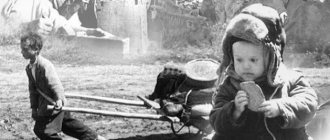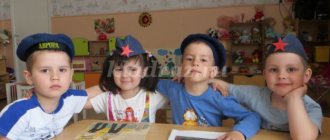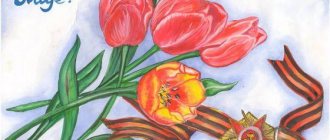Class hour "Heroes of War"
Goals: to introduce students to the biography of the famous pilot, to cultivate a sense of patriotism, pride in their compatriots, to expand knowledge about the history of the Great Patriotic War and military aviation of those years.
Equipment: screen, media projector, computer, speakers.
Progress of the event.
I Organizational moment.
II Main part
Teacher's opening speech. A story about the main stages of the Great Patriotic War, the story is accompanied by a presentation.
A student makes a report about the biography of a pilot
Gareev Musa Gaisinovich - squadron commander of the 76th Guards Assault Aviation Regiment of the 1st Guards Assault Aviation Division of the 1st Air Army of the 3rd Belorussian Front. Born on June 9, 1922 in the village of Ilyakshide, now Ilishevsky district of Bashkiria, into a peasant family. Bashkir. Member of the CPSU(b)/CPSU since April 1944. He graduated from the 2nd year technical school of the People's Commissariat of Railways in 1940. He was drafted into the Red Army on December 15, 1940 by the Zhdanovsky district military registration and enlistment office of the city of Ufa, Bashkir Autonomous Soviet Socialist Republic. In 1942 he graduated from the Engels Military Aviation School. After graduating from aviation school, from September 25, 1942 - in the active army. He began his combat career as a sergeant - an ordinary pilot. In 1944 he became squadron commander. He ended the war as a major, regiment navigator. He fought in the battles of Stalingrad, Donbass, Crimea, Belarus, Lithuania, Poland, East Prussia. The contribution made by M.G. Gareev in the defeat of the Nazi invaders serves as a shining example of courage, courage and heroism, boundless love and devotion to the Motherland.
Student message.
Excerpt from the award list of the guard captain M.G. Gareeva:
“...Combat work on the Ilyushin comrade. Gareev began in 1942 over the burning Stalingrad... Despite the fact that over Stalingrad there was still an advantage of enemy aircraft in the air, a huge amount of anti-aircraft artillery, comrade. Gareev flew and performed excellent combat missions. In total, for the defense of the city of Stalingrad, he carried out 11 successful combat missions on the Ilyushin. It was a good Stalingrad training, the highest school of valor and heroism... The Don steppes and especially the Miusfront were the next stage of military valor and heroism, skill and education for comrade. Gareeva... Here he already successfully flew on combat missions as the leader of a pair and a flight. He flew in large groups - up to 100 aircraft, worked as a “photographer”, hovering alone over the group, and worked on the front line, breaking into strong German defensive fortifications, burning tanks and destroying manpower... powerful bombing and assault strikes by comrade. Gareev became a threat to enemy tanks. Like no one else, he was distinguished by his skill and courage, his desire to defend his homeland in the days when the German tank division “Totenkopf” was defeated. She was completely defeated even before she entered the battle. To attack this tank group, Comrade. Gareev made 7 combat missions. Fifty-eight tanks were destroyed as a result of the skillful and joint work of groups of our attack aircraft. Only one comrade. Gareev destroyed four tanks from this number... In the fight for the liberation of Donbass, comrade. Gareev became a lieutenant. By the time the operation to clear the Donbass of the Germans began, he had a fair amount of combat experience... He did not know fatigue, flew three and four times a day to attack enemy retreating columns, and destroyed enemy manpower and equipment from a strafing flight. On one of the combat days, Gareev, with six Ilovs, destroyed up to 15 German aircraft at an enemy airfield. Comrade was always sent to the most difficult combat missions. Gareev. He was exceptionally skillful in carrying out assault strikes on enemy airfields. Near Nikopol, he became a hunter, flew in pairs, looked for enemy tanks and aircraft and destroyed them. Every day his experience grew noticeably, the range of combat work expanded, and his sense of responsibility grew. Here he began leading groups. He was already replacing the squadron commander. Liberating Crimea and the city of Sevastopol, he became a senior lieutenant and was the first to fly his plane beyond Sivash. He worked a lot and intensely in Crimea. The last “Sevastopol” sorties were especially difficult and intense. He, and every pilot, had not seen such anti-aircraft fire since his first raids on Stalingrad... Attacking under such conditions was a difficult and extremely complex, dangerous task. Despite this difficulty, Comrade. Gareev conducted up to three dozen attack missions against enemy targets here... He began the liberation of Belarus and Lithuania with the rank of captain and squadron commander. Every flight of the group comrade. The Germans felt Gareev as a formidable force of Soviet weapons. He always acts boldly and decisively, skillfully and suddenly. Bombs and storms the enemy, always making at least six passes over the target. Always emerges victorious in any situation... Currently, the pilots of the squadron, Comrade. Gareev, under his command, inflict powerful blows on the German invaders near East Prussia... For heroism, courage and bravery shown in battles with the German occupiers, for successfully carrying out 164 combat sorties on the IL-2 aircraft, as a result of which great damage was inflicted on the enemy in manpower and technology, guard captain comrade. Gareev is worthy of being nominated for the highest government award, the title of Hero of the Soviet Union.”
A student recites a poem:
To the soldier of the Second World War , forgive me, soldier, that I cannot say a word, that there are tears in my throat again, again, that I am silent, looking into my eyes. Summons: “My son died at the front”... He fought, he was a soldier, He walked so many miles in the infantry, He so wanted to come back! I dreamed of saying: “Open the doors! Here I am: your grandson, your son, your brother! He believed so much in our Victory, He never hid his gaze! And it still hurts my soul that the soldier didn’t come home. An undying fire burns over an unmarked grave... Years of grief have flown by, But the mother will come to the threshold again: There is nothing stronger in the world Than maternal love.
Student message.
Excerpt from the award sheet of the Guard Major M. G. Gareev:
“... In the skies of East Prussia, comrade. Gareev fights with the rank of major. Here he smashes the German hordes with even greater hatred and skill. In poor weather conditions, he successfully leads his squadron into battle and carries out tasks accurately, crushing enemy equipment and manpower. His squadron is one of the first in the regiment in all combat work... Five times it was necessary to conduct an air battle with a superior number of enemy fighters of the FV-190 type. Always in these cases, Guard Major Comrade. Gareev immediately made the right decisions. By crashing into the formation of enemy fighters, he disrupted their battle formations and forced them to leave the battlefield. Thanks to the skillful organization of the battle, I never had the loss of driven crews. Guard Major Comrade. Gareev has exceptionally strong willpower. If he cannot carry out the task from a given height, then he descends to strafing altitude and destroys the enemy with assault actions. This is how he acted repeatedly to destroy the retreating enemy in East Prussia. Operates with exceptional accuracy over the battlefield. Every bomb he dropped, every shell and bullet fired hit exactly the target... On October 27, 1944, the leader of the group carried out a bombing and assault strike on enemy tanks in the Labegallen area, where in five passes he destroyed 2 tanks and knocked out one armored personnel carrier. On January 15, 1945, the leader of the group took off with the task of escorting our advancing infantry in the Tutshen area, where, despite strong opposition from anti-aircraft artillery, he destroyed 2 field artillery guns and caused 3 fires. 01/20/45 Guard Major Comrade. Gareev was given the task: to accompany our tanks in the direction of Insterburg. The area of operation was covered by anti-aircraft artillery, while enemy fighters were patrolling. Despite this, Comrade Gareev destroyed a strong resistance center in the Varkenen farmstead, where he destroyed 4 artillery pieces and 2 armored personnel carriers. On 02/05/45, the leader of the group carried out a strike to destroy tanks in the Kroitzburg area, where he personally destroyed one tank and one self-propelled gun. After the group’s work, the settlement the group was working on was occupied by our units. On 02/21/45, the leader of the group carried out a strike to destroy enemy artillery in the heavily fortified point of Rauschbach, where he personally destroyed 2 self-propelled guns and caused 3 fires. The difficult and difficult path from Stalingrad to the approaches to Koenigsberg was traversed by Guard Major Comrade. Gareev. This path is covered in glory and directed by the heroic exploits of his personal combat work. The defenders of Stalingrad and the liberators of Donbass and Crimea knew his skill in assault strikes. Now the liberators of Belarus and Lithuania see and know and are following with enthusiasm the work of Comrade. Gareev over the battlefield in the skies of East Prussia...With exceptional, boundless devotion to the socialist Motherland, throughout the entire Patriotic War he smashes the Nazi bandits, increasing the glory of Stalin's aviation and increasing the great exploits of our pilots...For the heroism, courage and bravery shown during the execution of 207 successful combat missions on an IL-2 aircraft, which resulted in great damage to the enemy in manpower and equipment, Hero of the Soviet Union, Major Comrade. Gareev is worthy of being nominated for the second Gold Star medal.
All material - see the archive.




